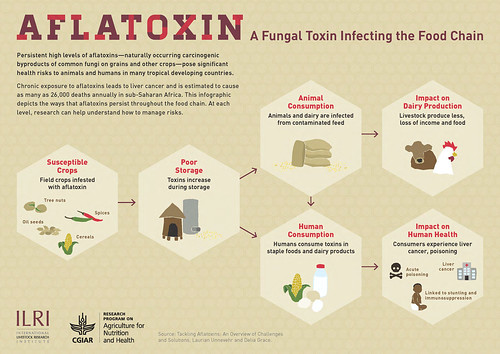
New ILRI study finds high levels of aflatoxin in milk and dairy feeds in Greater Addis Ababa milk shed
Aflatoxins are highly toxic fungal by-products produced by certain strains of Aspergillus fungi in more than 40 susceptible crops including maize and groundnuts. Aflatoxins can be separated into aflatoxins B1, B2, G1 and G2.
When ingested, aflatoxin B1 is metabolized to aflatoxin M1 which is secreted into milk. Aflatoxin B1 is particularly important because it has been found in most foods and animal feeds and is highly carcinogenic.
Aflatoxins cause around 90,000 cases of liver cancer each year and are strongly associated with stunting and immune suppression in children. Aflatoxins in contaminated animal feed can lead to reduced animal productivity. They can end up in products like milk, meat and eggs, thus presenting a health risk to humans, with children being particularly susceptible.
In Ethiopia, previous studies have investigated aflatoxin contamination in staple cereals, red chili pepper and ground peas. Now, a new research study published in the journal Food Control (6 July 2015) has, for the first time, documented aflatoxin contamination in milk and dairy feeds in Ethiopia and the results show that milk and dairy feeds in the Greater Addis Ababa milk shed are highly contaminated with aflatoxins.
The cross-sectional study by scientists from the International Livestock Research Institute (ILRI) was carried out in the Greater Addis Ababa milk shed between September 2014 and February 2015 in order to detect and quantify the levels of aflatoxin M1 in samples of raw cow’s milk and aflatoxin B1 in samples of dairy feed.
The Greater Addis Ababa milk shed was selected because it is a rapidly intensifying system where aflatoxins are likely to be an increasing problem. A value chain approach was used, whereby production, processing and marketing of dairy feeds and milk were examined, as well as milk sold to consumers in Addis Ababa.
A total of 110 milk samples (100 from dairy farmers and 10 from milk traders) and 156 dairy feed samples (114 from farmers and 42 from feed producers, processors and traders) were collected and analysed by enzyme-linked immunosorbent assay (ELISA).
The study analysed all the commonly used dairy feeds such as mixed concentrate feed, brewery by-products, maize grain, pea hulls and silage. The most common ingredients in concentrate feeds were wheat bran, noug cake, pea hulls and maize grain.
All the milk samples were found to be contaminated with aflatoxin M1. Over 90% of the milk samples contained aflatoxin M1 levels that exceeded the European Union limit of 0.05 micrograms per litre. Out of a total of 110 milk samples, only nine contained aflatoxin M1 levels below 0.05 micrograms per litre.
Similarly, all the feed samples were contaminated with aflatoxin B1, with levels ranging from 7 to 419 micrograms per kilogram. Along the value chain from farmers to feed manufacturers and traders, the levels of aflatoxin contamination were fairly similar.
Out of a total of 156 dairy feed samples, only 16 contained aflatoxin B1 at a level less than or equal to 10 micrograms per kilogram. At the same time, 41 feed samples contained aflatoxin B1 at levels exceeding 100 micrograms per kilogram.
There was a significant association between aflatoxin B1 contamination in concentrate feeds and the presence of noug cake in the feed.
Noug (Guizotia abyssinica or Niger seed) is an oilseed crop that is indigenous to Ethiopia. Noug seed is pressed to produce noug oil while the remaining noug cake is sold as animal feed to feed processors and dairy farmers. Noug cake is becoming increasingly popular among dairy farmers in Ethiopia because its high nutrient content increases animal productivity.
Noug cakes were found to be highly contaminated with aflatoxin B1 (290–397 micrograms per kilogram) while the other feed components (wheat bran, maize grain and Brewer’s dry yeast) had relatively low levels of aflatoxin.
For this reason, the authors of the study recommend that further research on aflatoxin risk mitigation should focus on noug cake so as to effectively reduce the risk of aflatoxin contamination in peri-urban and urban dairy value chains in Ethiopia. Risk assessment of aflatoxins in noug seed and its by-products in other food chains should also be carried out.
In addition, there is an overall need to increase awareness of aflatoxins and to support risk mitigation practices along the entire dairy value chain.
“Policymakers and development organization need to support the dissemination of information about good agricultural and storage practices and other simple risk-reduction measures,” the authors conclude.
Citation
Gizachew D, Szonyi B, Tegegne A, Hanson J and Grace D. Aflatoxin contamination of milk and dairy feeds in the Greater Addis Ababa milk shed, Ethiopia. Food Control 59(2016): 773-779.
You may download a 4-page brief of the research article at http://hdl.handle.net/10568/67116





















